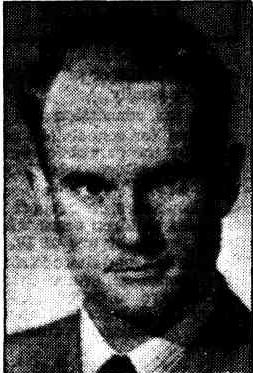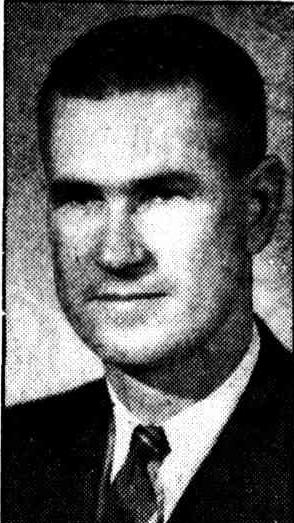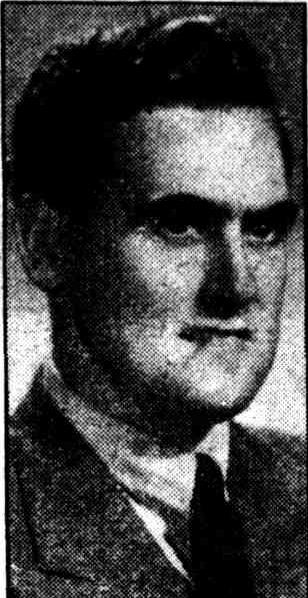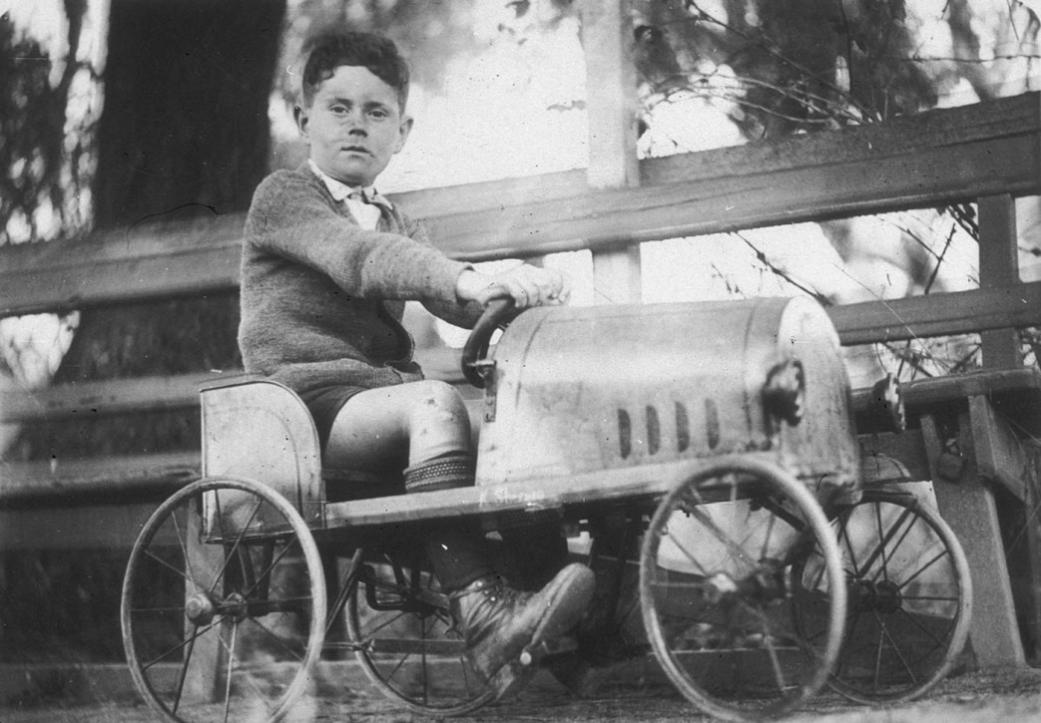A Mona Vale collector recently showed us this wonderful Cyclops scooter, vintage circa 1952, a similar version of which, not in as good condition, sold at Shannons' 2014 Spring auction for $1400.00.
Collecting vintage toys, especially those made by Australian manufacturers, or those that are close to some revisited childhood memory, is ensuring some of these great examples of our past are surviving to be seen by those who were once part of an unimaginable future. Cyclops Toys remain popular because they were of very good quality, and so some great examples can still be found in close to mint condition, which always commands a higher price among collectors, and because they were a part of so many people's past.
Those who are new collectors should take the time to research the type of toys they plan to collect. Learn which symbols to look for on certain toys and how to identify them by brand. Study the manufacturers by learning the production process and the identifying marks they used. Know which year each company produced the toys collected and have a solid knowledge of the toy history, as well as the company history. We've included an overview here of cyclops, but of course it's much more involved than that.
There are some great websites which have much more material an people with knowledge and experience overseeing them - for Cyclops and associated steel or tin toys we'd suggest Old Bike - an online museum, keep and eye on the Shannons seasonal auctions - or finding a copy of a book written about Cyclops by Marjory Faignes, 'Cyclops Through the Years - Australia's Childhood Icon''.
The best method for new collectors to determine which type of toys to collect is to collect what they like, bearing in mind how they are going to store them, if they are larger items such as scooters and push-pedal cars, and how to restore them if they are ensuring their budget meets what is available in their price range.
As shown above, some items will retain good prices if they are rare and in good condition.
What may also be of interest to local people is that Arthur Murch, one time Mona Vale and Avalon Beach resident and a consummate creator in scultpure, painting - so many mediums, began an apprenticeship in 1917 with John Heine & Son in Leichhardt. Arthur studied mechanical drawing at Sydney Technical College at night and became an engineer’s draughtsman, remaining with John Heine until 1924 and probably learning muvch there that helped him in his work later on.
Whether a tricycle, a dinkie, a scooter, pedal car or pram, many of us or our siblings had one or a succession of these 'made for fun' items - and thousands of Australians had some connection with the company, if not through its products, then through working for or knowing someone who did work for them.
Originally founded as J. Heine &Co. in 1888 in Redfern by John Heine senior, who came to Australia in 1879 from Devonshire per the Northumberland, and then becoming 'Dial' Engineering Works in 1899, this engineering firm became John Heine and Sons, and began manufacturing Cyclops Toys from around 1913.
Born Buckfastleigh, Devon, England, 14 February 1857, John Heine Snr. was apprenticed to Wilcocks and Son, millwrights and founders, in Buckfastleigh 1873-77. Some sources state he emigrated to Australia/New Zealand circa 1881, working as a labourer building dry stone walls in New Zealand ca 1882-83. He was a tradesman and later foreman, at Howe & Rowe, sheet metal machines circa 1884-85; an unsuccessful gold prospector and later blacksmith to prospectors circa 1885; and established as a sole trader, J. Heine - making butcher's shop equipment (carcass rails and hooks, meat mincing machines, sausage fillers and brine pumps). In 1886 he manufactured first inclinable press (own design and manufacture) 1895; made eldest son (John jnr) partner, John Heine & Son ca 1907. First prize at Royal Agricultural Society Show for sheet metal working machinery (own design and manufacture) 1891; first prize at Royal Agricultural Society Show for can making machinery (own design and manufacture) 1892.
WANTED IMPROVER to fitting and turning. Apply John Heine, engineer, 17, Gibbons-street, Redfern. Advertising (
1888, September 24).
The Sydney Morning Herald (NSW : 1842 - 1954), p. 14. Retrieved from
http://nla.gov.au/nla.news-article13697610
JOHN HEINE,
17, Gibbons-street,
REDFERN,
Manufacturer of Tinsmiths' or Plumbers Machinery, Dies, round, oval, or square, Compound or Triple Action, made to order. Advertising (1888, December 29). The Australian Star (Sydney, NSW : 1887 - 1909), p. 2. Retrieved from http://nla.gov.au/nla.news-article228424542
Winning government contracts for needed equipment increased his ability to invest in property and expand his business. The Australian national Archives lists over 30 patents for improvements, many of these patents held by his sons.
Government Railways of New South Wales, Secretary's Office, Sydney, 12th March, 1890.
THE undermentioned Tenders hare been accepted by the Railway Commissioners, viz. :—
J. Heine & Co.—Supply of Metal By-passes for Gas-fittings for Railway Carriages. Government Gazette Tenders and Contracts (
1890, March 14).
New South Wales Government Gazette (Sydney, NSW : 1832 - 1900), p. 2324. Retrieved from
http://nla.gov.au/nla.news-article222113629
Department of Public Works, Sydney, 12th July, 1892. THE following Tenders have been accepted:
John Heine—Supply, &c., of New Engines for Launch for Dredge Service. Government Gazette Tenders and Contracts (
1892, July 12).
New South Wales Government Gazette (Sydney, NSW : 1832 - 1900), p. 5618. Retrieved from
http://nla.gov.au/nla.news-article222108742
Dial engineering works.
ANNUAL PICNIC.
The Dial Engineering Works of Redfern held their second annual picnic at Correy's Gardens, Cabarita, on Saturday, 80 being present at the luncheon, Alderman Lane, of Granville, being in the chair. The toast of the firm was proposed by Mr. J. Jargdine, foreman, who alluded to the recent extension of the firm's operations, and to the amicable relations that existed between the employers and employees.
Mr. J. Heine responding. "The Visitors" was proposed by Mr. Trimington, and was acknowledged by Mr. G. Renwick, of Messrs. M'Lean, Bros, and Rigg, and Mr. W. Atkins (Atkins and Sons), and the representatives of M'Pherson and Son. Other toasts given were "The Ladies" and "The Day we Celebrate," DIAL ENGINEERING WORKS. (
1901, December 9).
The Daily Telegraph (Sydney, NSW : 1883 - 1923), p. 3. Retrieved from
http://nla.gov.au/nla.news-article237378860
DIAL ENGINEERING EMPLOYEES' PICNIC.
The employees of Messrs, J. Heine and Son, George-street, Redfern; held their annual picnic at Correy’s Gardens. A number of visitors were present, also many members of the fair sex, and an enjoyable outing resulted. At the luncheon, the chair was taken by Mr. J. Heine, sen.
In proposing the toast of the firm, Mr. J. Heine, jun., spoke of the success of their business, and advantage of having a number of engineering firms, instead of one. huge State monopoly. To-day Australia was passing through a state of 'transition, and if not encumbered with an over supply of legislation, in a few brief years the country would be greatly enriched. In the part, private enterprise had built up this country, and if left alone. individual enterprise will provide plenty of work, and pay good wages to all who are willing to work. A big programme of sports, was provided. The results of the principal 'events were: — Men's Handicap: L. Heinisch, 1; J. Jardyne, 2. Apprentices Handicap: C. Arnold, 1; N. M'Leod, 2. Young Ladies' Race-: Miss F. Wilder, 1; Miss Higgs, 2. Walking Match: H. Lane, 1; J. M'Gregor, 2. Novelty Race: Mrs. R. J. T. Tregonlng, 1; Mrs. C. Shea, 2. Old Buffers' Race: T. Sorrell, 1; S. Smith, 2. DIAL ENGINEERING EMPLOYEES' PICNIC. (
1905, October 24).
Evening News (Sydney, NSW : 1869 - 1931), p. 6. Retrieved from
http://nla.gov.au/nla.news-article113287563
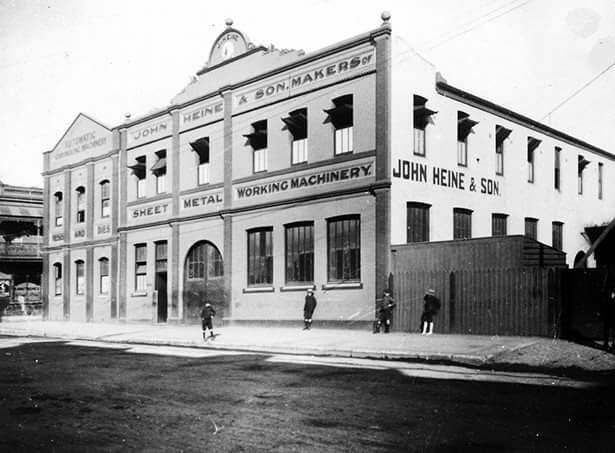
John Heine and Sons at Redfern, circa 1905
About 1900 Mr. Heine perfected an automatic body-forming and side soldering machine for making food cans and supplied the Sydney Jam Company. He continued to make improvements and in 1907 developed the Model 4G, which dominated can-making in Australia for about 20 years.
JOHN HEINE- ENGINEER.
Another exhibit to provoke thought is that of John Heine, of the 'Dial' Engineering Works, 88 and 90 George-street, Redfern. Mr. Heine is a manufacturer of meat and fruit preserving and canning appliances, tinsmiths' and plumbers' machinery, presses, dies. etc. The general idea is that while we can turn out good manufactured articles, we have to import the machinery to do so, but here is an example to the contrary. The machinery is made in Sydney for the manufacturers, and so successfully that Mr. Heine writes us that to show how our machinery is in favour with local manufacturers, every tin exhibited through the pavilions has been made with our machinery.' And he adds this significant sentence, 'As several people can hardly believe that machinery of such a high standard is made in Sydney, we extend an invitation to the incredulous to visit our factory, and see the whole process from the foundry to the finishing shop.'
That is an invitation that ought to be availed of. In fact, in connection with this exhibition So many people have expressed wonderment at the excellence of the manufactures exhibited on the various stands, and incredulity that they could be made here, that it might be worth the while of certain manufacturers to consider whether it would not profit them to arrange an occasional visiting day, which could be well advertised, and might lead to a new appreciation of their manufactures. We appear now to be reaching the stage which proved so important in America, when we not only make the goods, but invent and make new processes and machines to make them. Mr. Heine's exhibit is an example in point. It consists chiefly of a collection of sheet metal-working machines, hard at work turning out artistic fancy boxes as souvenirs of the exhibition. This type of machinery is used by plumbers, tinsmiths, and canmakers for turning out canisters, tubs, buckets, metal ceilings, biscuit tins, match and tobacco boxes, etc. The machines are at work each afternoon and evening, and they are so well made as to be easily worked, even with unskilled labour. One of Mr. Heine's latest productions makes 'down pipes' from one and a half inch to six inches diameter, in 6ft or 8ft lengths. Other machines used in the sheet metal trade, such as presses and dies, rollers and folders, side seamers, angle benders and burring machines, are also shown.
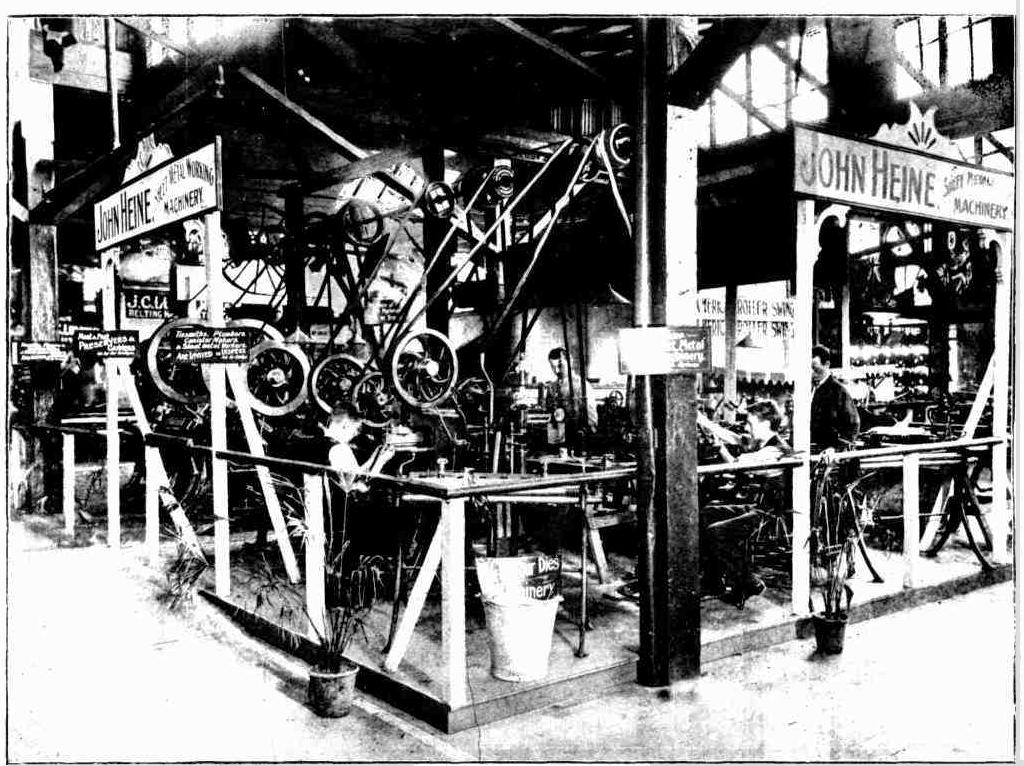
AMID THE WHIRR.
LOCAL INDUSTRIES.
AS SEEN AT THE A.N.A. EXHIBITION. xxiii— John Heine’s engineering works
The working exhibit of John Heine, of the "Dial" Engineering Works, 88 and 90 George-street, Redfern, at the A.N.A. Exhibition, is without doubt the best of all the working exhibits. As several sceptics have found it difficult to believe that machinery of such a high standard as that exhibited is manufactured in Sydney, Mr. Heine extends an Invitation to those gentlemen, and anyone else, to visit the "Dial" Engineering Works, where they can see for themselves the machinery In course of construction. The business was founded by Mr. John Heine eighteen years ago, and the hands now employed number 60. The works have been extended into three departments— main engineering shop, blacksmiths and boilermaking shop, and foundry, occupying a frontage in all of 250ft. Although Mr. Heine is quite prepared to carry on the ordinary engineering work, yet the special business of the "Dial" Engineering Works is the manufacture of sheet-metal working machinery. Trade in this line demands a very high standard of excellence, and, recognising this, the "Dial" Engineering Works are fully and adequately equipped with the latest and most accurate 'machinery and methods of production.
The founder of the business (Mr. John Heine) commenced with the manufacture of ordinary tinsmiths and plumbers’ machinery, such as axle-benders, rollers, folders, burring machines, and other such implements used by sheet-metal workers. Then, With the Introduction of the fruit and meat preserving Industries, came the demand for can-making machinery, which has been one of the main lines ever since. Mr. Heine's works have supplied plants to almost all the large meat and fruit preserving firms In the 'Commonwealth and New Zealand. With his up-to-date can-making machinery the making of cans and tin-canisters has become comparatively an easy matter, and to the ordinary observer it is somewhat amazing to see these articles produced with such cheapness, rapidity, and uniformity. But this Is not only the case with .the cans, boxes, &c. Numerous other articles such as - buckets, tubs, wash bowls, trunks, metal ceilings, die., are just as easily, manufactured In this and the other States with machinery, which the "Dial" Engineering Works have made a speciality to supply. These are classified under power presses and dies, drop hammers, shearing machines, seamers, and other magnificent machine tools, which will cut, bend, form, spin', curl, stretch and compress bar and sheet metal Into any desired form. In the action of these tools' the "Dial" Engineering Works have a mechanical-reproductive process, wherein, the brain of the designer has been expended on specialised tools, which will produce pre-determined articles and parts In a wonderfully uniform, cheap, and rapid manner. Bar sheet metal working machinery bears the same relation to the blacksmith's or ' tin-smith's work that printing does to the scrivener's art, chrome-making to oil-painting, or a knitting-machine to one's grandmother.
The experience of Mr. John Heine has been that, when taken in hand and properly trained, the Australian workman Is capable of working to as high a standard as the work-plan of any other country in the world. The Australian is in nine cases out of ten more quick-witted and Intelligent than the foreigner, and, If treated fairly, will always do his work thoroughly and well.
Mr. Heine has found the operation of the Federal tariff with regard to machinery rather peculiar. Automatic can-making machinery (one of the "Dial" Engineering Works' chief line of manufacture) is duty free. Power-presses, which are essentially a part of the can-making machinery, being used to stamp the taps and bottoms of cans, it described as tin-stamping presses, are dutiable up to 12 ½ per cent.'; but if described as metal capsule-making machines, which they also are, as by a change of dies they will produce capsules for preserving jars etc., they are admitted duty free.
When one reflects on the multitudinous variety of metal articles and parts which are annually imported Into the Commonwealth, such as enamelled hollow-ware, lamps, and other domestic utensils, cartridge-cases, bicycle parts, and agricultural Implements, silver and electroplated ware, It will readily be seen that .the possibilities for the use of this sheet metal working machinery are enormous. If the more ordinary articles, such as trunks, sheet metal, piping, tubs, metal ceilings; . &c., can. be manufactured In Australia, why not the whole list of Imported articles enumerated above. To do so would be of great material advantage to the workmen of Australia, Inasmuch as where Mr. John Heine now employs 60, he would employ five times the number.. Arid other manufacturers in the same line would do the same. The cry that these articles cannot be manufactured in Australia is nothing more nor less than 'the cry of prejudice. It rests with such manufacturers as Mr. Heine to dispel that- prejudice by a practical proof of what Australian brains and labour are capable of doing, as exemplified by the splendid working exhibit at the A.N.A. Exhibition. LOCAL INDUSTRIES. (
1906, January 19).
The Australian Star (Sydney, NSW : 1887 - 1909), p. 5. Retrieved from
http://nla.gov.au/nla.news-article229645098
Department of the Attorney-General and of Justice,
Sydney, 5th July, 1911.
HIS Excellency the Lieutenant-Governor, with the advice of the Executive Council, has, in accordance with the recommendation submitted by the Industrial-Court constituted under the ''Industrial Disputes Act, 1908," and with the provisions of that Act, as amended by the "Industrial Disputes (Amendment) Act, 15)08," been pleased to appoint the undermentioned persons to be Members of a Board constituted for the industries of engineers, angle-iron smiths, fitters, turners, pattern-makers, blacksmiths, springsmiths, spring fitters, coppersmiths, brass-finishers, planers, borers, slotters, millers, shapers, drillers, machinists, and all other persons engaged in the engineering and iron trades excepting boilermakers in all branches of boilermaking, iron-ship builders, iron moulders, tinsmiths, sheet-iron workers, and ironworkers' assistants, for the State of New South Wales, excepting the Electoral Districts of Broken Hill, Sturt, and Cobar, excepting from the said Board the employees of the Chief Railway Commissioner, and the employees of the Council of the City of Sydney, and the employees of the Metropolitan Board of Water Supply and Sewerage, and the employees of the Sulphide Corporation at their works at Cockle Creek, and the employees of the Commonwealth Portland Cement Company, and all persons under any existing Boards or awards, and to be known as the Iron Trades (State) Board: -
On behalf of the Employers.
Mr. Henry John Vale, of Messieurs Vale and Sons, Auburn; and
Mr. John Heine, Junior, of Messieurs, John Heine and Sons, George-street, Redfern.
On behalf of the Employees.
Mr. William George Knight, of 14 Rowntree-street, Balmain; and
Mr. A damson Berkley Dawson, of 49 Morris-street, Summer Hill.
W. A. HOLMAN.
ACTION FOR EJECTMENT.
In No. 3 Jury Court this afternoon, before Mr. Justice. Ferguson, John Heine, of Redfern, engineer, brought an action against Richard Curry to recover possession of the shop and premises known as 558 Old South Head-road, Woollahra, occupied by the defendants as a weekly tenant. Mr. I. B. Norris (instructed by- Mr. M. J. Brown), appeared for the plaintiff. There was no appearance on, behalf of the defendant, and by direction of his Honor a verdict was entered for the plaintiff. ACTION FOR EJECTMENT. (
1912, March 28).
The Sun (Sydney, NSW : 1910 - 1954), p. 7 (FINAL EXTRA). Retrieved from
http://nla.gov.au/nla.news-article222008128
The factory was moved to Hay Street Leichhardt by 1913 and then the Heines building their own factory at Allen and Francis Streets in the same suburb in 1917. The firsat toys, with three wheels, alike their famous logo, were tricycles, go-carts and trolleys, sometimes and later called 'waggons'.
PRESS HANDS- Wanted, smart young MAN 18-19, must be experienced and Willing to Learn Apply, before 1 o clock today, THE CYCLOPS MANUFACTURING COMPANY, Hay street, Leichhardt. Advertising (
1913, September 13).
The Sydney Morning Herald (NSW : 1842 - 1954), p. 29. Retrieved from
http://nla.gov.au/nla.news-article15449807
WANTED, strong LAD for press and bench work,constant employment and good prospects for smart lad.
THE CYCLOPS MANUFACTURING CO
Department of Labour and Industry,
Sydney, 24th February, 1915.
IN pursuance of the provisions of the 44 Industrial Arbitration Act, 1912," and upon the recommendation of the Court of Industrial Arbitration, New South Wales, I, John Estell, Minister for Labour and Industry, being the Minister of the Crown administering the said Act, do hereby appoint Mr. John Heine, junior, of John Heine & Sons. Limited, George street, Redfern, as one of the members representing the Employers on the Iron and Shipbuilding Trades Group, No. 1 Board, In place of Mr. R. It. King, resigned, and for the residue of the period for which the said Mr. R. R. King was appointed.
JOHN ESTELL,
Minister for Labour and Industry. Government Gazette Appointments and Employment (
1915, February 24).
Government Gazette of the State of New South Wales (Sydney, NSW : 1901 - 2001), p. 1292. Retrieved from
http://nla.gov.au/nla.news-article227054596
BOY wanted," 16-17 for light machine work, good opening for smart boy.
CYCLOPS MFG. CO., Metal Toy Manufacturers,
Out at Leichhardt the Cyclops Manufacturing Company is turning out thousands of tricycles, go-carts, and trolleys every year for the youth of Australia. The factory was only started two years ago, but has gone ahead with leaps and bounds ever since. At first the manager experienced the same difficulty that evidently awaited any manufacturer who had the temerity to commence an enterprise in his own country. When he went for orders he invariably received the reply, "Locally made? Sorry, but we import all our stuff, mostly from America,"
This preference is not as strong as it was, and in consequence this particular factory is turning out goods at such a rate that they have not even accommodation to store them, awaiting removal. Thousands of wheels litter the floor and hang upon nails in every direction, like so many giant spider webs, poles, axles, and gaudily painted seats are strewn around in such quantity that one wonders how the pieces ever manage to find themselves and come together so as to provide a first-class tricycle or cart for a small boy. That they do accomplish this seemingly impossible feat is evidenced by the rows and rows of these children's vehicles that stand stacked upstairs, patiently waiting for the van that will come and remove them to the shops, and later the particular toy department of their destination.
Everything about these articles is made in Australia, and made well. Even the machinery, with the exception of the Electric Welder, is made here. The steel, of course, is imported, and as one instance of the gigantic leap of prices since the war this material alone has gone up 75 per cent. There was a time when "Made in Germany" was not such a grim joke as it is today, and people were accustomed to seeing that label on most of tho articles they bought as they were to taking sugar In their tea. That label has become now a stigma, and has vanished as surely as our respect for and belief in tho much-vaunted Culture of Germany. In place of the "Made in Germany" articles all goods have now a label pasted on them which reads "Made in England," or France, or Japan, or America, or, in fact, any country that is not assisting tho Kaiser with his degenerate warfare. That being tho ease, one wonders why tho label "Made in Australia" is not flaunted in the face of the purchaser, the same as those others are. Although she is producing such an increased percentage of the goods displayed in the shops this Christmas, nowhere is a little sign proudly boasted "Made in Australia."SANTA CLAUS IN SYDNEY SHOPS (
1915, December 21).
The Sun (Sydney, NSW : 1910 - 1954), p. 2. Retrieved from
http://nla.gov.au/nla.news-article221933290
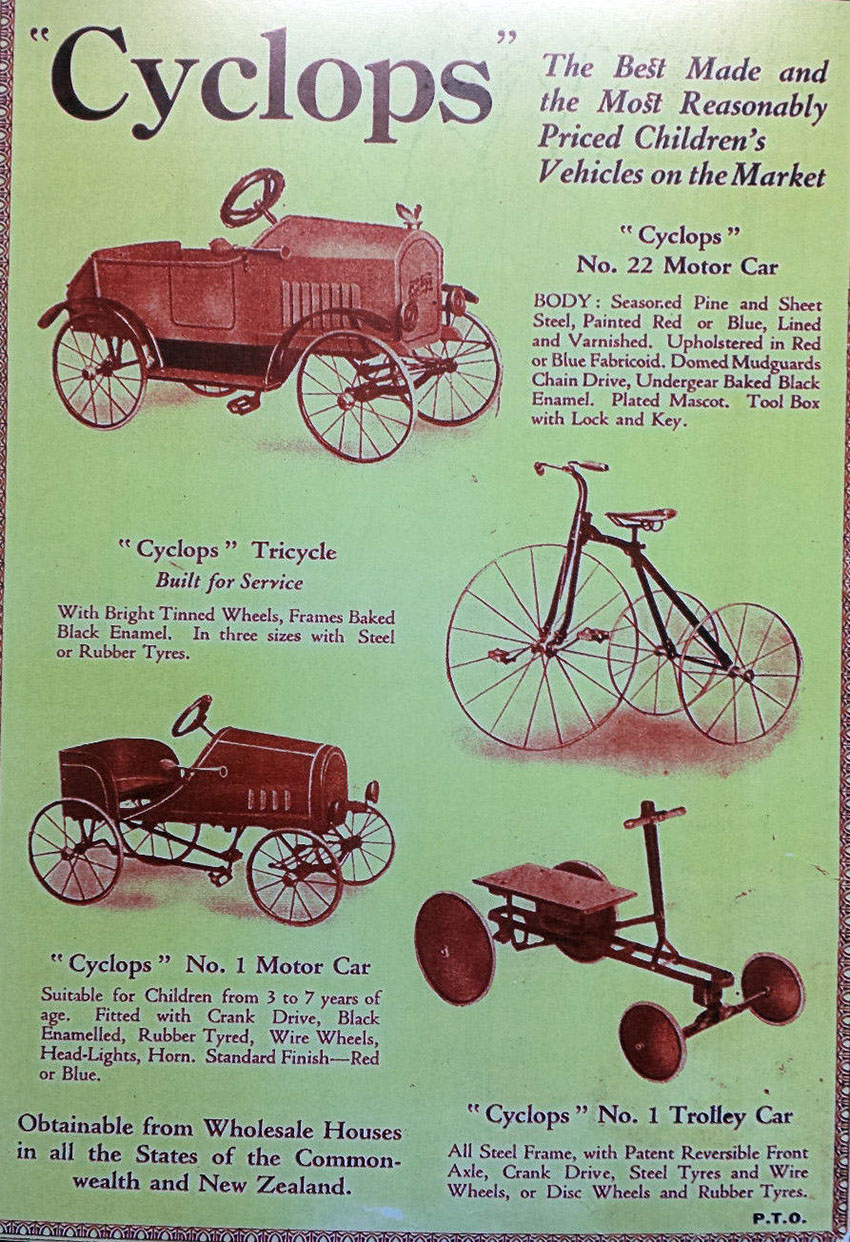
1920's Cyclops advertisement
In 1915 the Cyclops brand name was registered. Cyclops became hugely popular however with the launch in 1917 of their first pedal car. Many models were produced, often based on real car designs by Chevrolet, Chrysler and Packard. These sold in their thousands between the 1920s and 1950s.
Cyclops 'Pontiacci', circa 1940 - photo courtesy Shannons
The new factory, built in Leichhardt, and recently coveted to residential flats, was cited as a great example of what a factory could be:
THE MAKING OF TINS IN AUSTRALIA .
Automatic Machines That Turn Out 160 Per Minute HEINE'S MODEL FACTORY
Visitors to the Manufactures Exhibition at the Show Ground will have noted the widespread interest taken in machinery when in action. There is a fascination in, watching machines do things, just-, as there is in following the movements of a master craftsman doing a novel piece of work.
One of the machines which holds the attention of sightseers at the exhibition is the automatic stamping press of John Heine and Son Ltd., the well-known engineering firm, whose factory at Leichhardt is one of the show places of Sydney's industrial life. We all know the wonderful variety of things that are made from tin and sheet metal in these modern days. They range from tea and coffee tins and billies, to buckets, and wash bowl's, from fruit, jam, milk and tobacco tins to metal ceilings; stoves and trunks, gutter pipes and corrugated iron tanks. So many of these things are used in every day life that their manufacture on a large scale is a necessity. Also the/ must be cheap. Hence the growing use of labor-saving machinery in the production of these indispensible articles.
Supplying the Brains.
This is where the firm of John Heine and Son, Ltd., plays a most useful role. Heine's do not make any of the articles we have enumerated, but they make the machines that make those articles. That is to say, they supply the brains of the can-making industry. They design and construct the machines to do the work speedily and automatically. That is their speciality. They leave to others the production of the tinware which plays so large a part in the economy of our existence. It is' one of the firm's boasts that its machines have- laid the foundation of every sheet metal working factory and every meat and fruit canning factory in Australia. For 30 years they have been filling this pioneer role, and in that time must have contributed enormously to the national well-being. The invention of labor-saving- machinery and devices not' only tends to increase production, but also to reduce the cost of commodities to the consumer. Heine and Son have placed many kinds of labor-saving devices on the market and the canned fruit trade has been especially fortunate in being able to obtain its machinery locally, while other industries have been hampered by the necessity of having to get their machinery abroad.
Human-like Attributes.
Though the exhibit at the Show Ground gives but a small idea of the range of work covered in the factory, one section of it none the less impresses one with the almost human-like attributes which it is possible to impart to cold metal. The automatic stamping press, seen in operation, is an interesting and absorbing study. It reduces, the making of fruit and jam tins, for example, to a ridiculously few movements, the parts being turned out and neatly stacked for assembling at a rate of 160 a minute. The firm of John Heine and Son has been in existence 30 years. Four years ago it moved from Redfern to a new and more commodious site at Leichhardt. Its up-to-date factory is one of the show places of the neighborhood. It covers 4 ½ acres, and there is plenty of space available for extensions.
Where Men Work Gladly.
In its internal economy the factory seems a perfect model of what a modern, hygienic engineering shop ought to be. Plenty of light, and air, room to move about, clean floors, no holes or corners in which dirt can accumulate, large and convenient offices, adequate facilities for the workmen to wash themselves and to prepare and cat their food. In fact, a man is specially set apart to look after the men's comfort in the dining-room, which is a large hall completely open down one side to the light and air, with a seat and table combined for each workman. Mien work gladly in a factory like Heine's! Their surroundings are bright and healthy. Order and system are everywhere. Consequently everything runs smoothly. No need to run about asking questions. The routine board shows at a glance in what department a particular order may be found, and the state of its progress from the date it was put in hand. Apart from the automatic machines which are capable of turning out many thousands of tin containers per hour entirely without hand labor, Heine and Co. manufacture all kinds of machinery and tools for meat and fruit canneries, and sheet metal workers generally.THE MAKING OF TINS IN AUSTRALIA (
1922, October 15).
Sunday Times (Sydney, NSW : 1895 - 1930), p. 5. Retrieved from
http://nla.gov.au/nla.news-article128217123
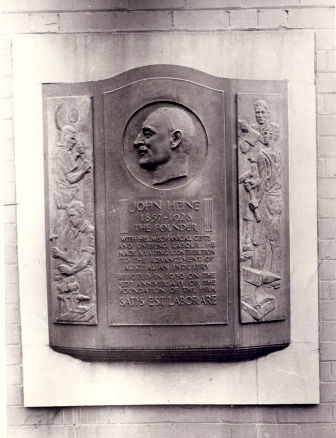 OBITUARY. MR JOHN HEINE, SEN.
OBITUARY. MR JOHN HEINE, SEN.The death occurred yesterday of Mr. John Heine, of Dalhousie-street, Haberfield, at the age of 71 years. Mr. Heine was a native of Devonshire, and came to Australia in 1879. He was an engineer by profession, and, in 1888, founded the business now known as John Heine and Son, Limited. The business has grown to be one of the most important machinery-making works In Australasia. It was founded in Redfern and, in 1917, a new factory was built at Allen and Francis streets, Leichhardt.
Mr. Heine was actively engaged in the business up to his illness. He is survived by a widow and four sons, viz., Mr. John Heine, junior, president of the Metal Trades Employers' Association, Mr. Alfred Heine, who is at present making a business tour in America, Mr. Victor Heine, and Mr. William Heine (all of whom are associated with the firm of John Heine and Son, Limited), and a daughter, Mrs. J. T. Adcock. OBITUARY. (
1928, August 15).
The Sydney Morning Herald (NSW : 1842 - 1954), p. 17. Retrieved from
http://nla.gov.au/nla.news-article16486648
WEALTHY ENGINEER
LATE JOHN HEINE ESTATE VALUED AT £65,410
John Heine, senr., of Haberfield, engineer, died, aged 72 years, on August 14, and his estate has now been sworn at £65,410. He appointed his sons, John, Alfred, and Victor Heine, executors and trustees, and to his widow, Elizabeth Ann Heine, he left his household furniture and effects. He also left to her his property in Dalhousie-street, Haberfield, and after her death, for his son Alfred. Mr. Heine left his land and property in Hordern-street, Newtown, upon which were erected eight houses and factory premises, to his son Victor. His land and property in Juliett-street, Enmore, including 14 cottages, were left to his son William. The residue of his estate was left for the benefit of his children in equal shares. In a codicil with his will, Mr. Heine left to his son, John, Alfred, Victor and William Heine, all his shares In John Heine and Sons, Ltd., and to his sons, John, Alfred and Victor Heine, all his shares in Cyclops, Ltd. WEALTHY ENGINEER (
1928, November 8).
The Sun (Sydney, NSW : 1910 - 1954), p. 12 (LAST RACE EDITION). Retrieved from
http://nla.gov.au/nla.news-article223251533
The sons took on the work, John Heine's eldest son of the same name
MR. FORDE.
VISITS FACTORIES.
The Acting Minister for Customs (Mr. Forde) visited four factories yesterday morning-John Heine and Sons, Ltd., Marrickville, Cyclops, Ltd., Marrickville, Shellonite. Ltd.. Marrickville, and A J. Thomas, Rosebery.
At Heine's machinery works the Minister saw all classes of sheet metal work. He was particularly interested in a toggle double action press for hollow ware. This machine stamps out aluminium dishes, kettles, and other utensils. Another machine, with two operations, stamps a length of guttering. The working of a machine for making metal lids was explained to the Minister, who remarked on the smooth running of the motor. Mr Heine told the Minister that It was of Australian manufacture.
Fifty-five different models of toy motor cars, tricycles, and other toys of that description are made by Cyclops, Ltd.
"I am surprised. I did not think you made anything like this," said Mr. Forde, as he handled what was described as a deluxe toy motor car. MR. FORDE. (
1930, May 13).
The Sydney Morning Herald (NSW : 1842 - 1954), p. 12. Retrieved from
http://nla.gov.au/nla.news-article16683601
'Cyclops' Dinkie.
All boys know the value of the word 'Cyclops' on their dinkies or bikes, and Aunt Merrythought can buy these goods at prices to suit father's pocket. For the small boy she would suggest a 'Cyclops' dinkie that is fitted with disc wheels, rubber tyres and rubber pedals, It is lacquered In red and blue, and Is designed for boys from two to five years old, The dinkie Illustrated has a nine-inch back wheel, and five-Inch front wheels, and the price Is only 19/0. This is a strongly made toy and will stand plenty of wear and tear.
Cyclops ''Dinkie'' trike - courtesy state Library of NSW
'Cyclops' Tricycle.
A tricycle of the 'Cyclops' make is another favorite and is to be had in two sizes. It is fitted with rubber tyres and 10 frames and forks are finished with baked black enamel. The handle grips are of rubber. The size is suitable for children from two to four years old has a sixteen-inch front wheel, and is priced at 25/0 : the next size will suit a child from three to nine years old, and has a twenty-two Inch front wheel, the price being 34/0. 'Cyclops' Scooter.
Where Is the boy that does not wish to possess a scooter? Of course, It must be a 'Cyclops.' These scooters amuse boys for hours and the girls are not unfavorable to a lido on one. A scooter that Is fitted with seven-Inch disc wheels and half-Inch rubber tyres is priced at 12/0, and It Is fitted with a pressed steel footplate, wood handle and steel frame baked black enamel. The height from ground to handle is thirty-two Inches.
'Cyclops' Motor Car.
The small boy has a great desire to be Independent like Dad, with his motor car, so why not buy him a 'Cyclops' car that would delight the heart of any small boy or his sister. The child could pedal around for hours, which would be a great blessing to mother while on her household duties. There are several styles similar to the illustration, one of which only costs 38/0, It Is fitted with nine Inch wheels with rubber tyres, the length of the car being thirty Inches. This is the 'Star' motor and there Is also a 'Cyclops' Chevrolet of the same dimensions, but fitted with balloon disc wheels and half inch rubber tyres, The wheels are lacquered to match the body, making It a very attractive car. AROUND THE SHOPS (
1930, November 29).
The Farmer and Settler (Sydney, NSW : 1906 - 1955), p. 16. Retrieved from
http://nla.gov.au/nla.news-article117503992
Around the walls of the Gift Centre at Ludbrooks is Toyland. Here toys range from Rd to pounds. How I would have loved Santa Claus to bring me one of those beautiful Cyclop doll's prams, when I was six. Cyclops toys are guaranteed, and spare parts are available. As well as prams there are Cyclops tricycles, cars, and dinkies, (tricycle with flat wooden seat). 'Melissa' Goes Christmas Shopping (
1934, December 22).
Examiner (Launceston, Tas. : 1900 - 1954), p. 15 (DAILY). Retrieved from
http://nla.gov.au/nla.news-article51897293
A PARTY OF 23 COUNCILLORS and other members of the Metal Trades Employers' Association, who came from Sydney last flight to attend the meeting of the local branch of the organisation, inspected the Steel Works and other local industries today. The President (Mr. Heine) is standing thirteenth from the left, and on his left is the President of the local branch (Mr. H. B. Horley). The party also included the Vice-president of the Association (Mr. G. E. Griffin) and the following: —
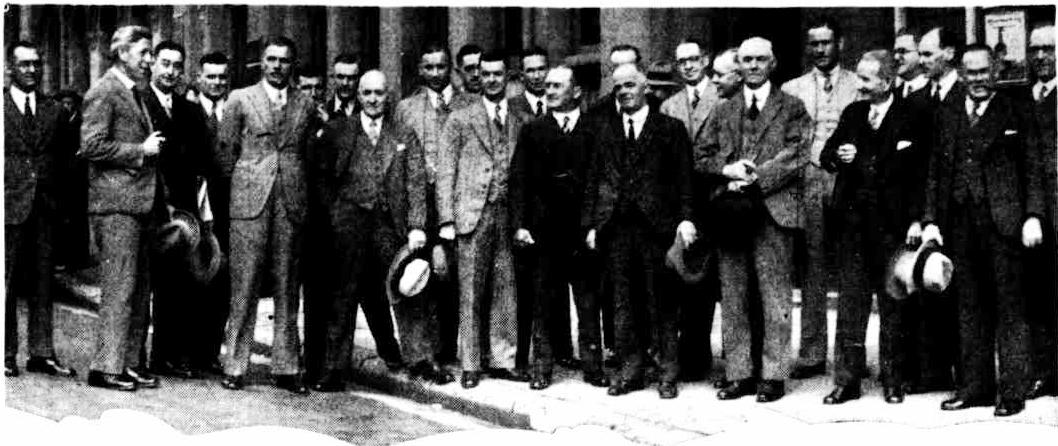
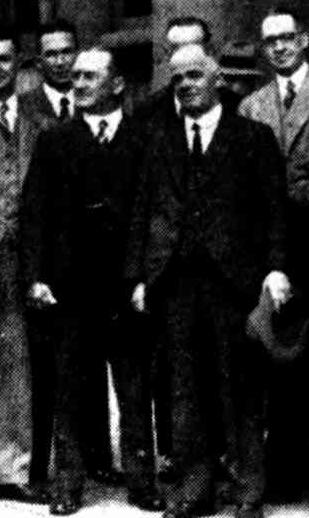
MEMBERS OF COUNCIL: Messrs. W. Courtney (Courtney and Bohlsen Ltd.); E. H. Dunnett (J. Gndsden Pty. Ltd.), P. T, Kavanagh (Kavanagli and English Ltd.), T. M. Ritchie (S. and M. Engineers Ltd.), R. J. Saunders (B. and S. Electrical Co. Ltd.), C. W. Squires (Malleable Castings Ltd.), T. W. Thornley (W. Thornley and Sons Ltd.). EX-COUNCILLORS: Messrs. W. Marr (Gordon Marr and Sons Ltd.), A. E. Fhippard (William Adams and Co. Ltd.), W. Tulloch (Tulloch's Phoenix Ironworks Ltd.).OTHER MEMBERS: Messrs. T. C. Byrne, A. J. Parsons (Australasian Scale Co. Ltd.), A. Heine (John Helno and Son Ltd.), A. Stewart (Hibberd Motors Ltd.), J. Bryden Brown (Electricity Meter Mfg. Co. Ltd.), — . Newman, — . Golder (The Ever Ready Co. Aust. Ltd.), G. Marr (Gordon Marr and Sons Ltd.). STAPP: Messrs. W. C. Myhlll (secretary), N. P. Miller (Tariff officer), L. L. Woolacott (of "The Australasian Manufacturer"). No title (
1934, October 18).
The Newcastle Sun (NSW : 1918 - 1954), p. 22. Retrieved from
http://nla.gov.au/nla.news-article166291563
One week's consignment of Cyclops Tricycles,
Motor Cars and Toys delivered in Perth from the Australian Factory. Our Members Say: (
1937, September 26).
Sunday Times (Perth, WA : 1902 - 1954), p. 31 (First Section). Retrieved from
http://nla.gov.au/nla.news-article58790587
CYCLOPS TOYS
For Health and Happiness
Every toy made by the Cyclops factory is guaranteed. Cyclops factory is one of the biggest institutions of its kind in Australia, and Australian boys and girls appreciate goods made in their own country.
To avoid disappointment, parents are advised to select their Cyclops toys immediately, as supplies are limited owing to their popularity and proved reliability.
The range consists of motor cars, trucks, tricycles, waggons, barrows, scooters, aeroplanes, prams, dinkies, etc and, of course, the baby brother or sister is catered for by the Cyclops stroller.
Cyclops toys bring Christmas joys, and one should always remember to look for the brand "Cyclops for Long Wear" on every toy. All city, sub-urban and country stores are now stocking Cyclops, so be sure and make your selection as soon as possible.
The beauty of a tricycle, motorcar, etc. made by Cyclops is that one can, obtain a toy to suit any purse or to fit a child of any age. The best materials are used, and although the quality is top grade, should any part be required, spares are always obtainable. CYCLOPS TOYS (
1937, November 21).
Sunday Times (Perth, WA : 1902 - 1954), p. 37 (First Section). Retrieved from
http://nla.gov.au/nla.news-article58795449
World War II meant the company had a new priority of course and shortages for metal for toys was to be expected. A few incidences mark their contributions:
2020-1 ) Requisition No. 9786.—Power presses, for Small Arms Factory, £205.—W. G. Goetz & Sons Ltd., Spotswood: £955 10s.—John Heine & Son Pty. Ltd.. Leichhardt, New South Wales. DEPARTMENT OF SUPPLY AND DEVELOPMENT. (1940, April 11).Commonwealth of Australia Gazette (National : 1901 - 1973), p. 801. Retrieved from http://nla.gov.au/nla.news-article232674790
No Pay, No Work
SYDNEY. Saturday.
Engineers employed by the Clyde Engineering Co. and at the works of John Heine and Sons Pty. Ltd. have decided not to resume work on Tuesday. As the two days' holiday pay which they claimed for the Christmas vacation was not in their pay envelopes yesterday they stated that they would not return to work on Tuesday but would hold a mass meeting in the morning. The stoppage will interfere with war efforts. The production of paravane supplies at the Clyde Engineering Company's works will be arrested, as will the manufacture of machine tools for munition production at the works of John Heine and Son. Unless an early settlement is reached it is possible that other employees at the works mentioned will be drawn into the dispute. No Pay, No Work (
1941, January 25).
The Daily News (Perth, WA : 1882 - 1950), p. 18 (FIRST EDITION). Retrieved from
http://nla.gov.au/nla.news-article84005150
TWO STRIKES SETTLED
SYDNEY, Friday.— The strikes at the works of the Clyde Engineering Co. and John Heine and Sons Pty. Ltd. were settled at a conference between the employers and the Amalgamated Engineering Union to-day. The Clyde Engineering Co. employees accepted the terms at a meeting and will resume work on Monday. The men at John Heine and Sons' will meet tomorrow, and it is expected that they also will resume on Monday. The dispute arose over payment for the Christmas holidays. TWO STRIKES SETTLED (
1941, February 1).
The Courier-Mail (Brisbane, Qld. : 1933 - 1954), p. 3. Retrieved from
http://nla.gov.au/nla.news-article44911052
11.178 Req. 1648.—Hand-operated curving rollers, for Department of the Army, £590.—John Heine& Son Pty. Ltd., N.S.W. DEPARTMENT OF SUPPLY AND DEVELOPMENT. (1942, August 6).Commonwealth of Australia Gazette (National : 1901 - 1973), p. 1973. Retrieved from http://nla.gov.au/nla.news-article232677195
5726 Req. 2507.—Spare parts, for Department of Munitions, £212 7s. 3d.—John Heine & Son Pty. Ltd., Leichhardt. DEPARTMENT OF SUPPLY AND SHIPPING. (1943, April 1). Commonwealth of Australia Gazette (National : 1901 - 1973), p. 767. Retrieved from http://nla.gov.au/nla.news-article232690830
METAL TRADES' GIFT SPITFIRE
This Spitfire, named "Metal Trade, Australia," was given to the R.A.F. by the Metal Trades Industry. It is now ready for battle. To pay for it, the president of the Metal Trades Employers' Association, Mr. John Heine, presented a cheque for £7,500 from the industry to the then Prime Minister, Mr. Menzies, in October, 1940. METAL TRADES' GIFT SPITFIRE (
1942, January 13).
The Sydney Morning Herald (NSW : 1842 - 1954), p. 9. Retrieved from
http://nla.gov.au/nla.news-article17783461
As these toys were built to last, those who were young enough to warrant that year's batch must have shared the previous years with their playmates. Advertisements taken out in magazines in December 1945 stated there would be a 'limited supply'for that Christmas - soon everything was returning to a measure of supply trying to meet demand:
THE HUNDREDS OF TOYS IN OUR TOY DEPT.
Cyclops Dinkie No. 9 .. .. 31/3
Cyclops Scooter No. 10 . . 39/3
Cyclops Scooter No. 3 . . 64/3
Cyclops Dinkie Express . . 40/
Peter Pan Waggon No. 0 . 12/11
Peter Pan Waggon No. 4 . 30/
Peter Pan Pram .. .. 58/1
Sunbeam Scooters .... 16/11
English Mechanical Train Sets on Rails . ..............12/9
English Mechanical Toys, assortment of 6 kinds. Special .. 3/11
Lawn Mowers .... .... 7/9 ea
Wood Pullalong Toys, assorted 3/1½ each.
Metal Pullalong Waggon 4/3 ea.
Table Tennis .. .... 6/11 set
Picture Blocks ...... 6/2 set
Mechanical Metal Timber Truck 7/4 ea.
Elephant Chimes ..... 5/10 ea.
Plastic Telephones . . . 14/11 ea
Mamma Dolls. 221n Sleeper .... 52/10 each.
Sleeping Doll with hair . 36/7 ea
Sleeping Doll; hard to break 29/9 each
English Rubber Squeaker Dolls 12/4 each.
English Rubber Squeaker Rocking Toys .............. 10/10 ea.
English Rubber Dog .... 7/4 ea.
Below run the pictures taken of this circa 1952 Cyclops Scooter - with rubber wheels, nice white trim and one of the first models to have a brake:
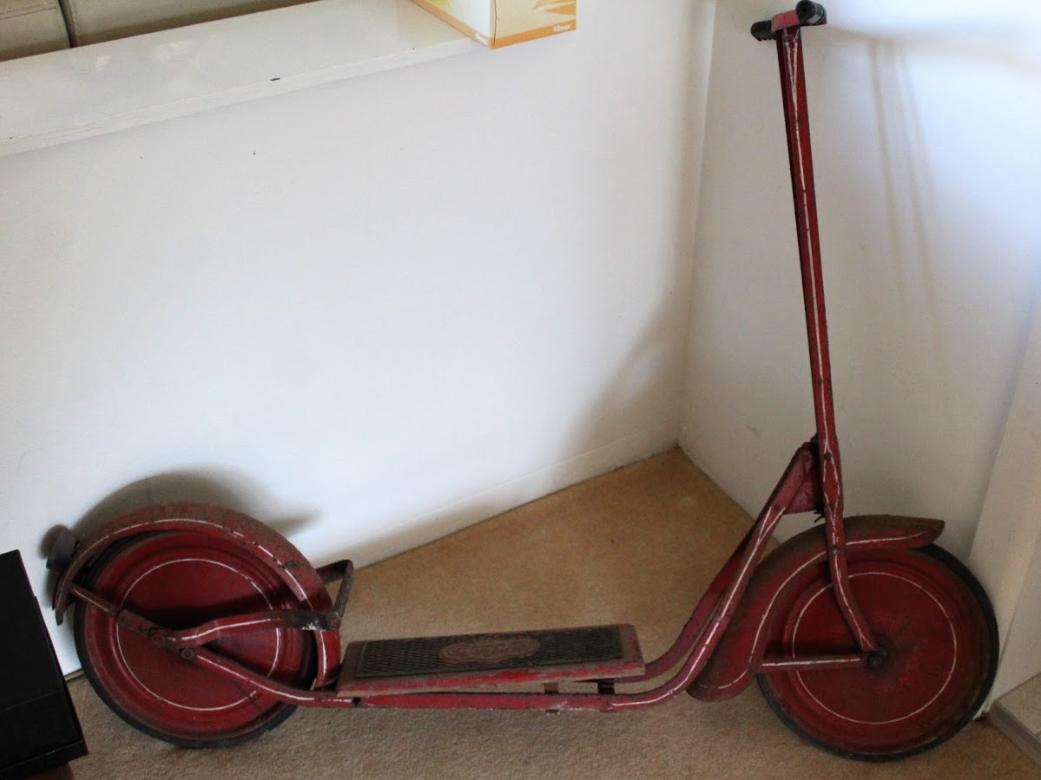
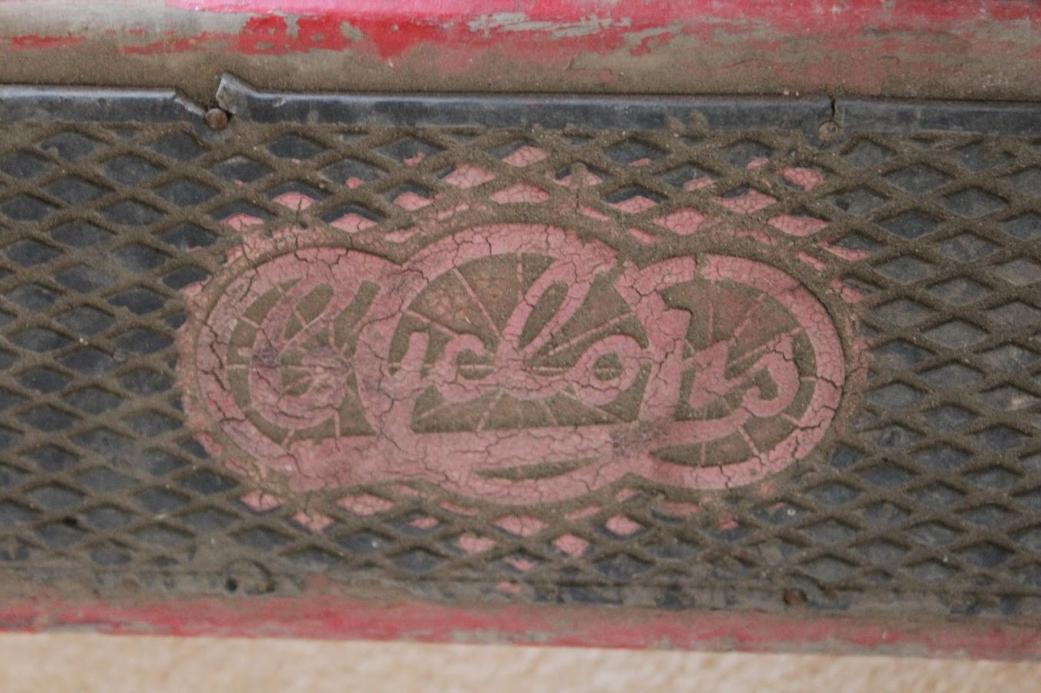



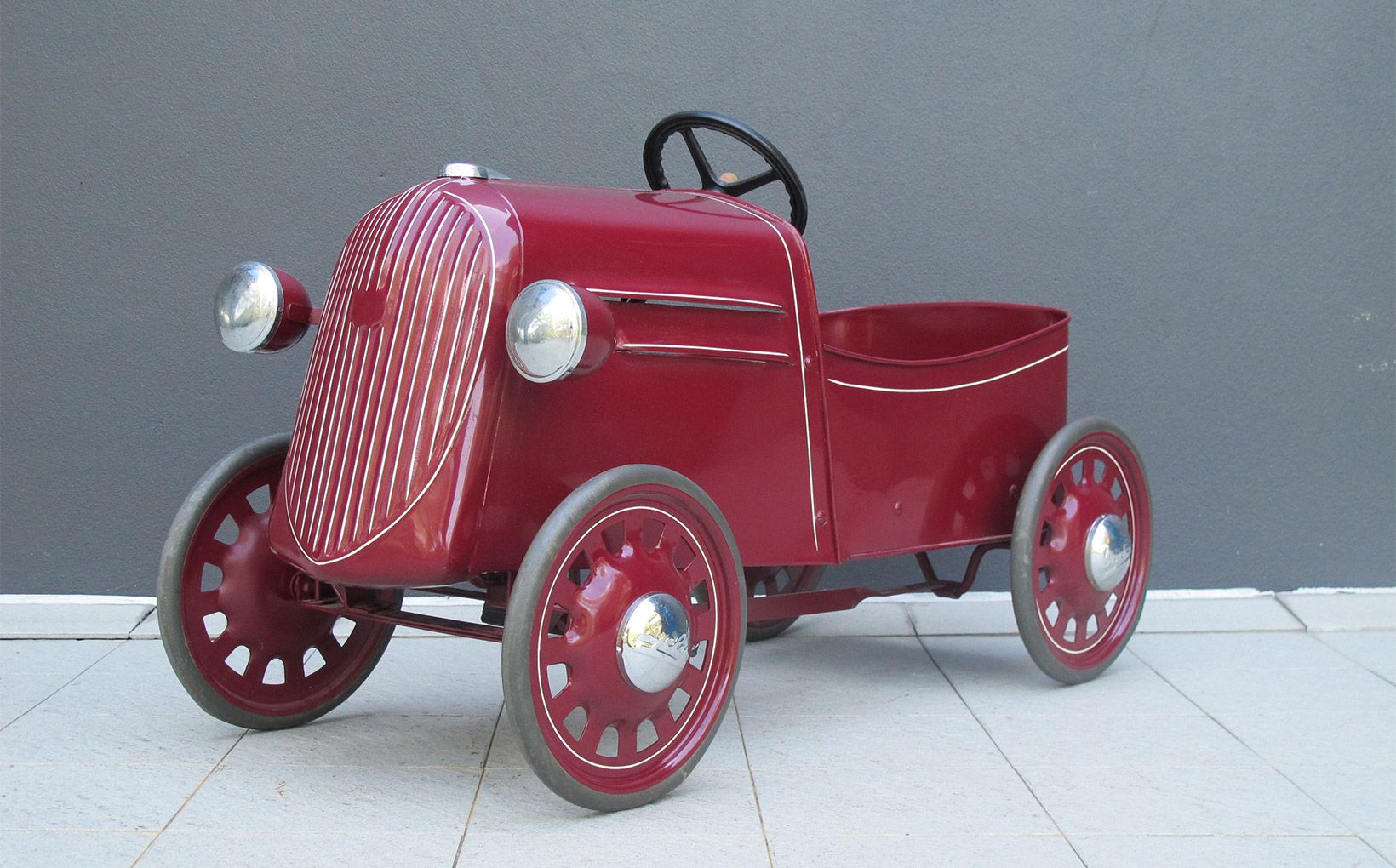
 OBITUARY. MR JOHN HEINE, SEN.
OBITUARY. MR JOHN HEINE, SEN.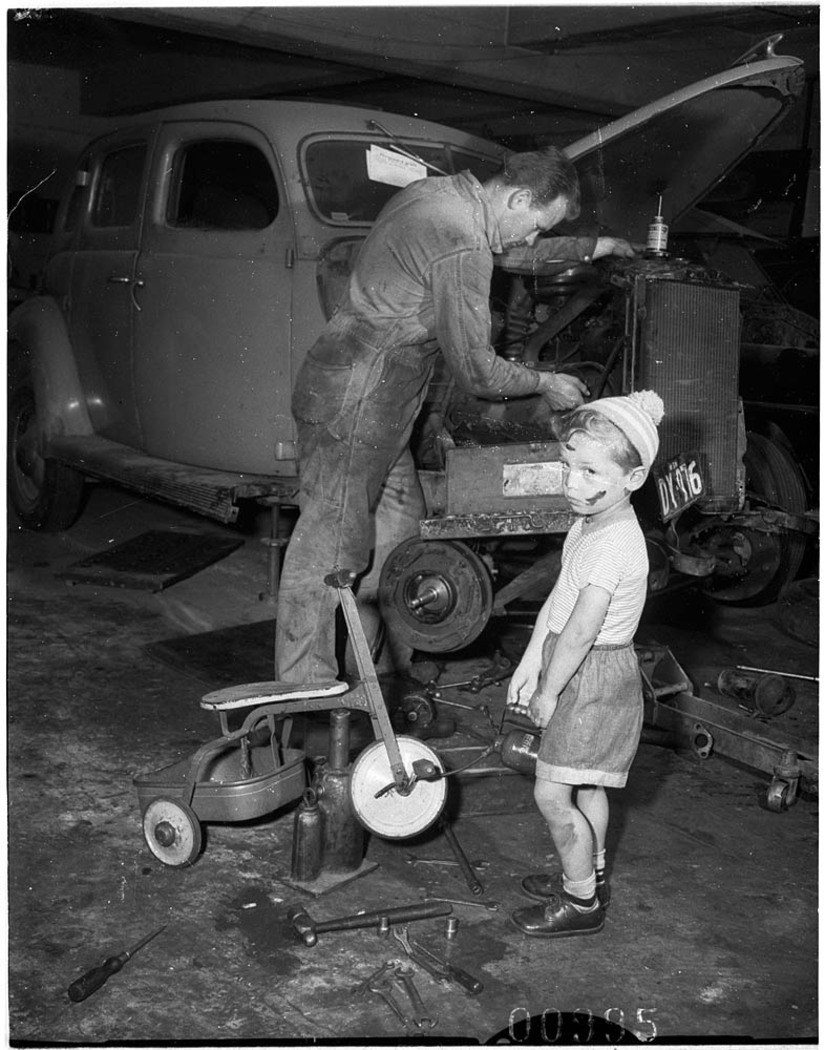


.jpg?timestamp=1500701981829)
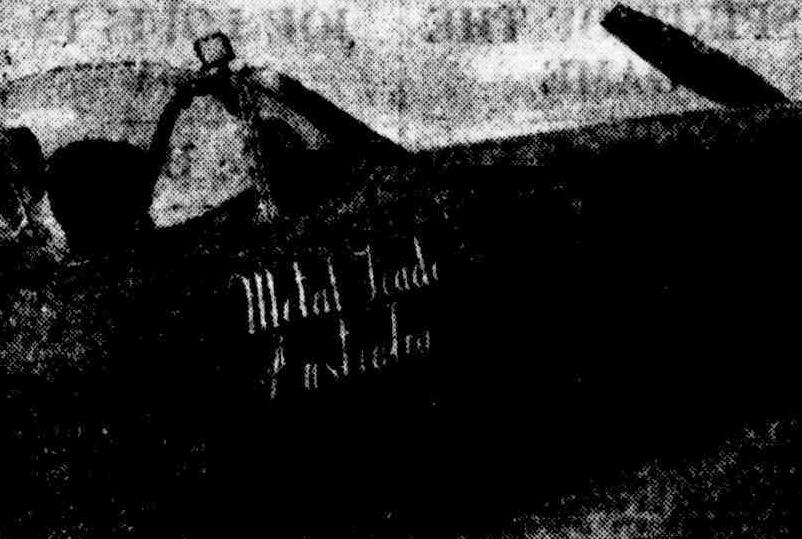
.jpg?timestamp=1500701398047)
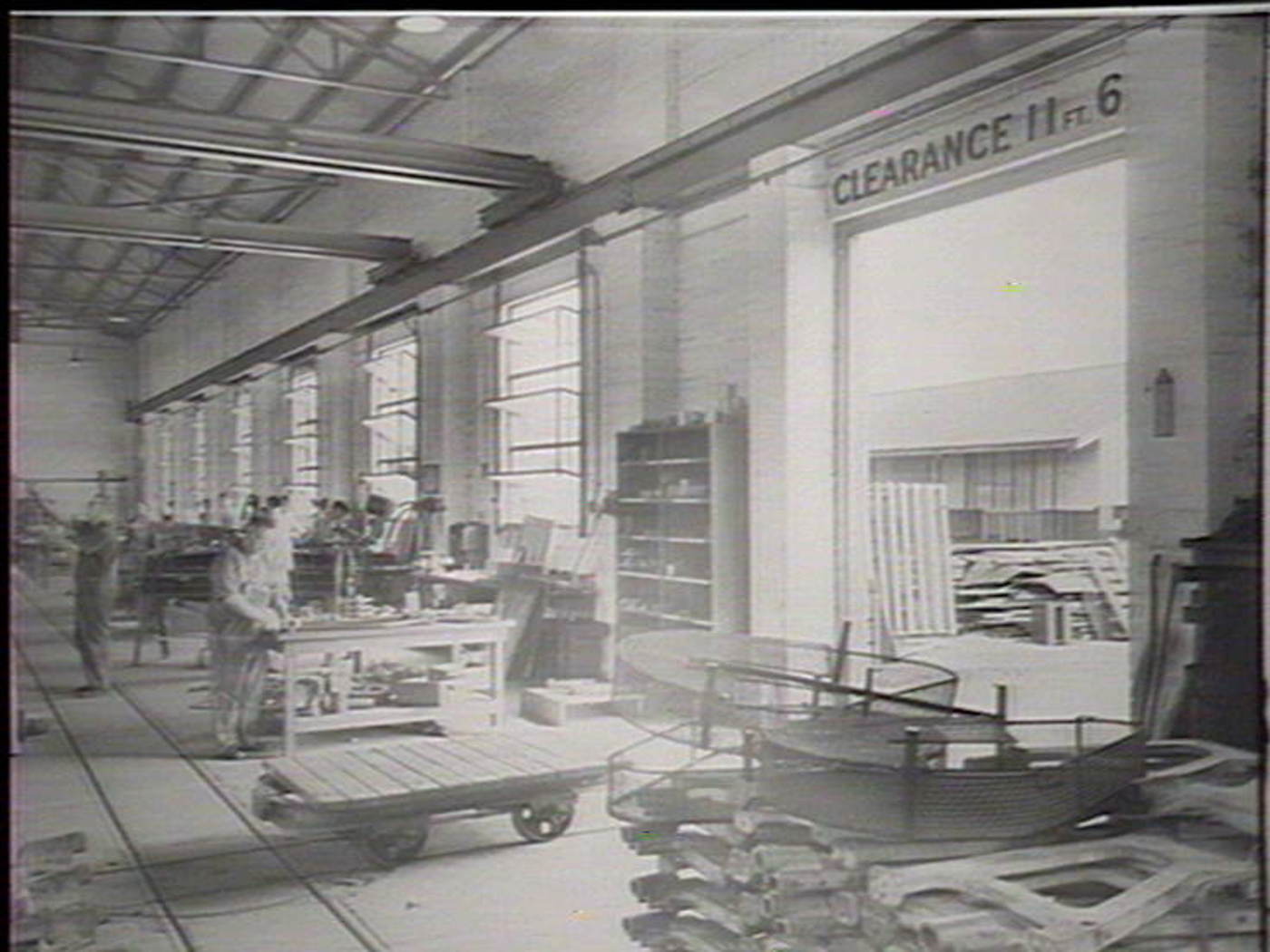

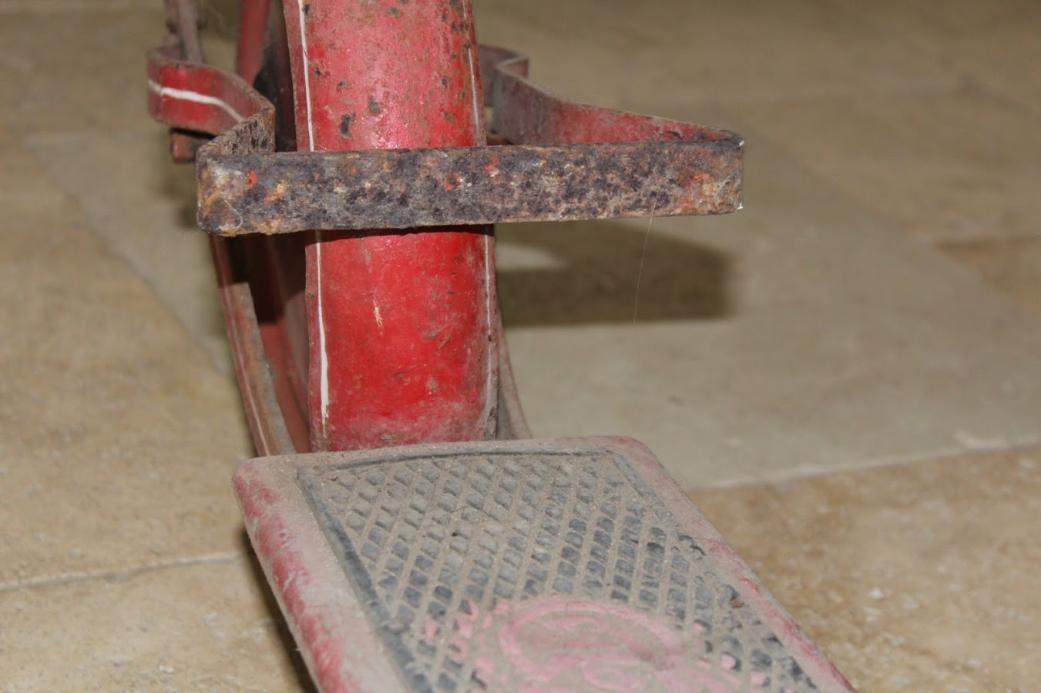
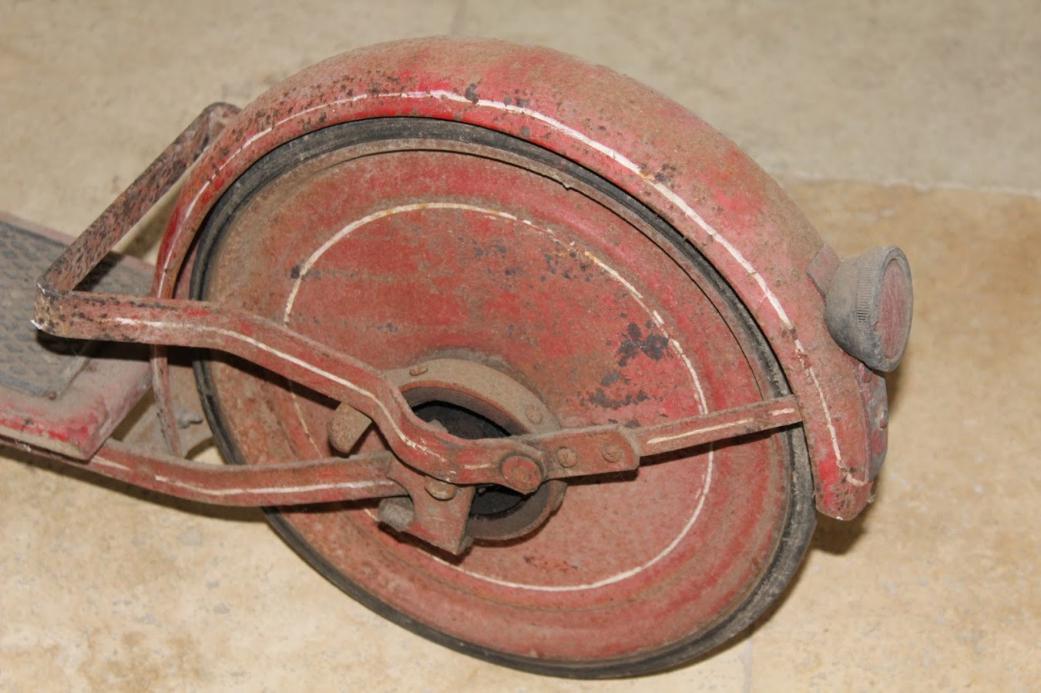
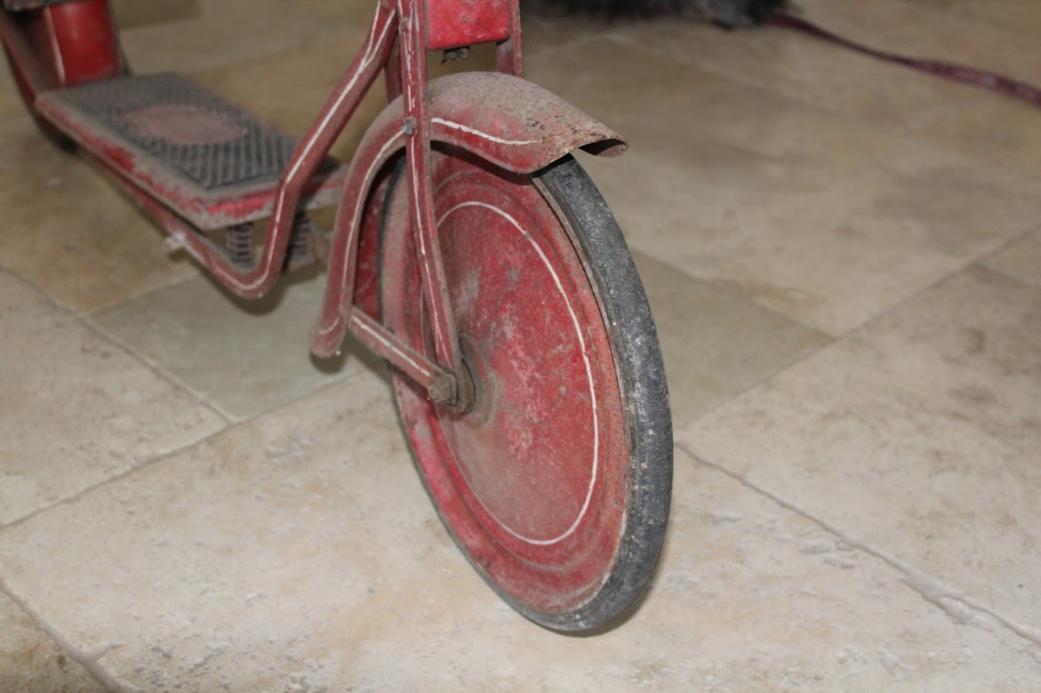
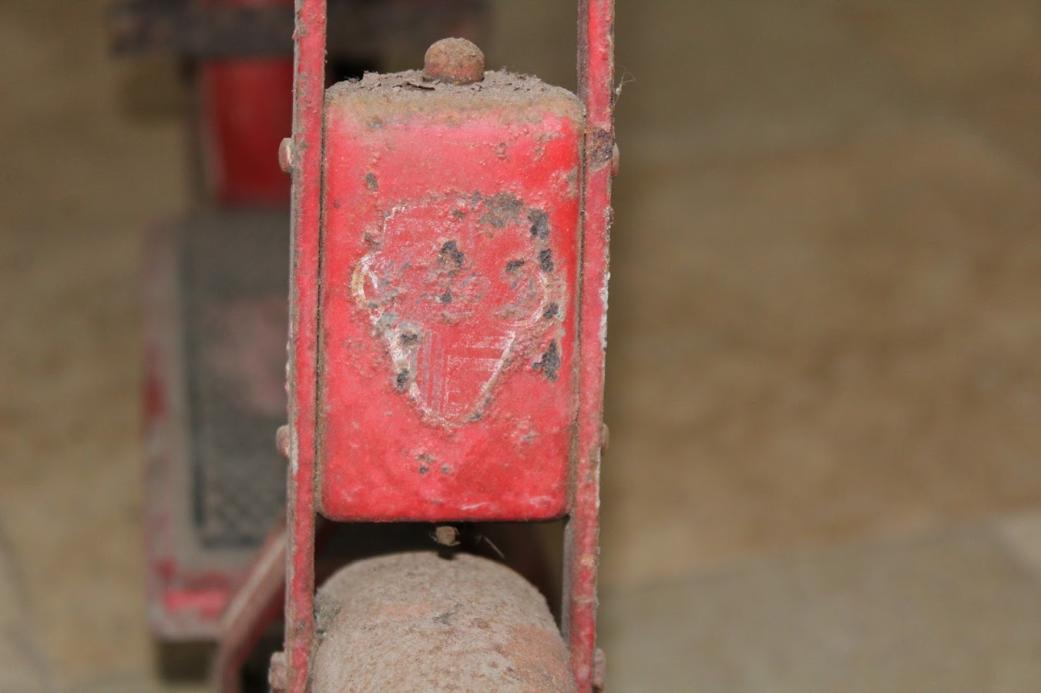
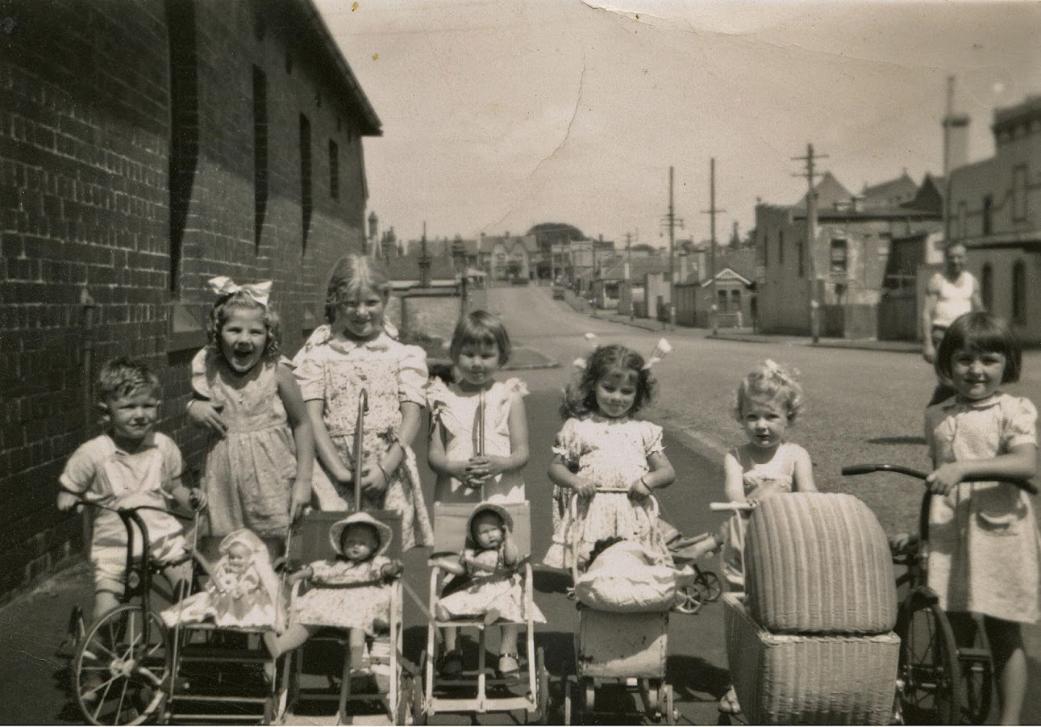
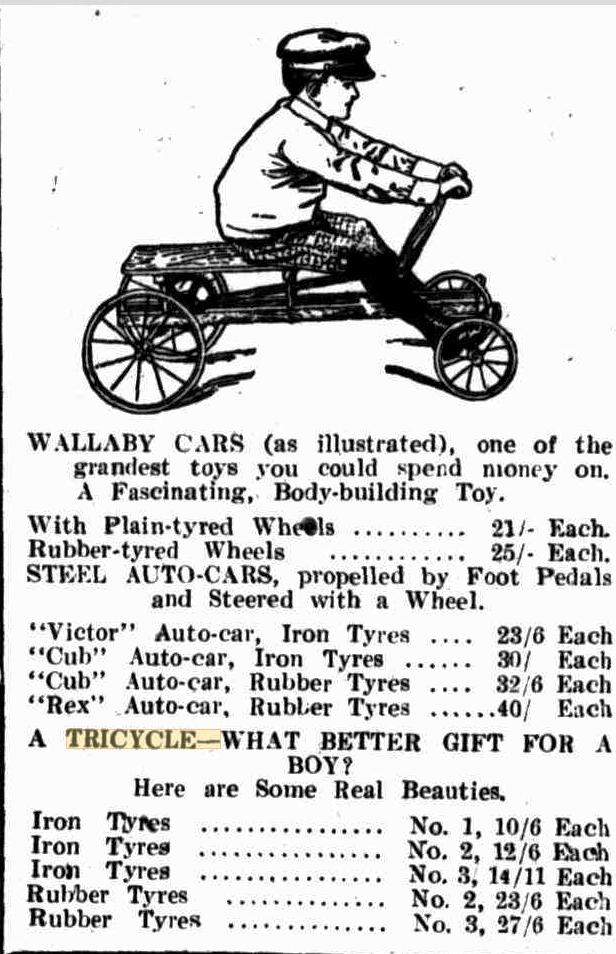
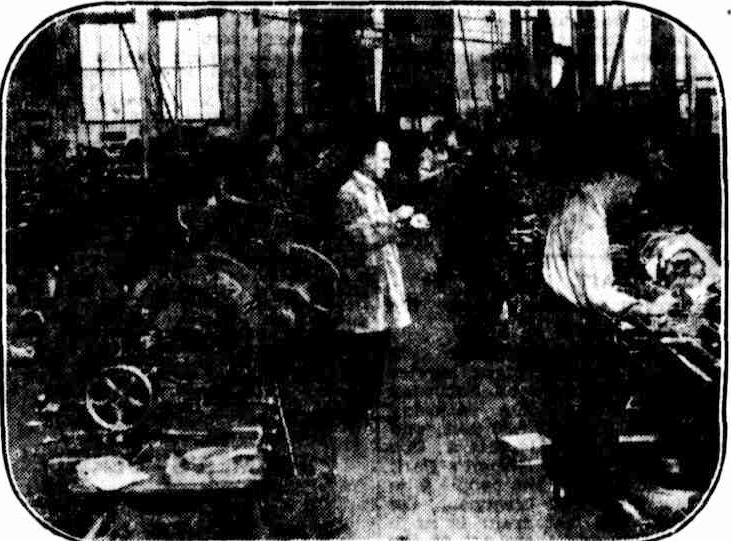
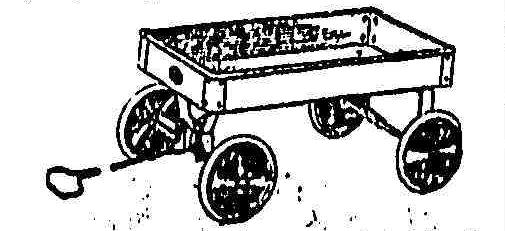 The name of 'Cyclops' on any toy Is a guarantee for quality and service. There are many toys of this brand on the list, one of which Is Illustrated. This Is a Cyclops waggon, strongly made and very attractively finished. The bright disc wheel, are fitted with rubber tyres which, of course, are favorites with the boys. The price of this waggon Is only 10/60. Cyclop's 'dinkies,' suitable for children from two to five years of age, may be had for 11/0. They are lacquered in blue and red and are fitted with disc wheels and rubber tyres, the front wheel being of seven inches and the back wheels five inches in diameter. The pedals are also covered with rubber, Other 'dinkies' may be had at higher prices. Cyclops scooters for the small toys may be had for 12/11. Cyclops tricycles for children from two to four years are priced at 20/0, from three to six years age and from three to nine years 33/0. AROUND THE SHOPS (1931, December 12). The Farmer and Settler (Sydney, NSW : 1906 - 1955), p. 14. Retrieved from http://nla.gov.au/nla.news-article117348547
The name of 'Cyclops' on any toy Is a guarantee for quality and service. There are many toys of this brand on the list, one of which Is Illustrated. This Is a Cyclops waggon, strongly made and very attractively finished. The bright disc wheel, are fitted with rubber tyres which, of course, are favorites with the boys. The price of this waggon Is only 10/60. Cyclop's 'dinkies,' suitable for children from two to five years of age, may be had for 11/0. They are lacquered in blue and red and are fitted with disc wheels and rubber tyres, the front wheel being of seven inches and the back wheels five inches in diameter. The pedals are also covered with rubber, Other 'dinkies' may be had at higher prices. Cyclops scooters for the small toys may be had for 12/11. Cyclops tricycles for children from two to four years are priced at 20/0, from three to six years age and from three to nine years 33/0. AROUND THE SHOPS (1931, December 12). The Farmer and Settler (Sydney, NSW : 1906 - 1955), p. 14. Retrieved from http://nla.gov.au/nla.news-article117348547